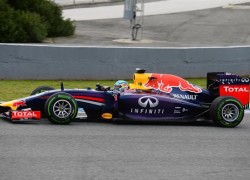
Following the announcement by the stewards that Daniel Ricciardo will be excluded from the Australian Grand Prix results, they’ve released a 10-point explanatinon on the ruling.
1) The Technical Delegate reported to the Stewards that Car 3 exceeded the required fuel mass flow of 100kg/h. (Article 5.1.4 of the Formula One Technical Regulations)
2) This parameter is outside of the control of the driver, Daniel Ricciardo.
3) The fuel flow is measured using the fuel flow sensor (Art. 5.10.3 & 5.10.4 of the Technical Regulations) which is homologated by the FIA and owned and operated by the team.
4) The stewards considered the history of the fitted fuel flow sensor, as described by the team and the Technical Delegate’s representative who administers the program. Their description of the history of the sensor matches.
a. During Practice 1 a difference in reading between the first three and Run 4 was detected. The same readings as Run 4 were observed throughout Practice 2.
b. The team used a different sensor on Saturday but did not get readings that were satisfactory to them or the FIA, so they were instructed to change the sensor within Parc Ferme on Saturday night.
c. They operated the original sensor during the race, which provided the same readings as Run 4 of Practice 1, and Practice 2.
5) The Stewards heard from the technical representative that when the sensor was installed on Saturday night, he instructed the team to apply an offset to their fuel flow such that the fuel flow would have been legal. He presented an email to the stewards that verified his instruction.
6) The technical representative stated to the Stewards that there is variation in the sensors. However, the sensors fall within a known range, and are individually calibrated. They then become the standard which the teams must use for their fuel flow.
7) The team stated that based on the difference observed between the two readings in P1, they considered the fuel flow sensor to be unreliable. Therefore, for the start of the race they chose to use their internal fuel flow model, rather than the values provided by the sensor, with the required offset.
8) Technical Directive 01614 (1 March 2014) provides the methodology by which the sensor will be used, and, should the sensor fail, the method by which the alternate model could be used.
a. The Technical Directive starts by stating: “The homologated fuel flow sensor will be the primary measurement of the fuel flow and will be used to check compliance with Articles 5.1.4 and 5.1.5 of the F1 Technical Regulations…” This is in conformity with Articles 5.10.3 and 5.10.4 of the Technical Regulations.
b. The Technical Directive goes on to state: “If at any time WE consider that the sensor has an issue which has not been detected by the system WE will communicate this to the team concerned and switch to a backup system” (emphasis added.)
c. The backup system is the calculated fuel flow model with a correction factor decided by the FIA.
9) The FIA technical representative observed thought the telemetry during the race that the fuel flow was too high and contacted the team, giving them the opportunity to follow his previous instruction, and reduce the fuel flow such that it was within the limit, as measured by the homologated sensor – and thus gave the team the opportunity to be within compliance. The team chose not to make this correction.
10) Under Art. 3.2 of the Sporting Regulations it is the duty of the team to ensure compliance with the Technical Regulations throughout the Event. Thus the Stewards find that:
A) The team chose to run the car using their fuel flow model, without direction from the FIA. This is a violation of the procedure within TD/ 01614.
B) That although the sensor showed a difference in readings between runs in P1, it remains the homologated and required sensor against which the team is obliged to measure their fuel flow, unless given permission by the FIA to do otherwise.
C) The Stewards were satisfied by the explanation of the technical representative that by making an adjustment as instructed, the team could have run within the allowable fuel flow.
D) That regardless of the team’s assertion that the sensor was fault, it is not within their discretion to run a different fuel flow measurement method without the permission of the FIA.



3 Responses to “Stewards Decision on Riccciardo Exclusion”
Trackbacks/Pingbacks
[…] Red Bull Team Principal, Christan Horner, remains adamant that the team complied fully with regulations governing the flue flow rate following Daniel Ricciardo’s exclusion from the Australian Grand Prix. […]
[…] called into the stewards’ office as celebrations were no doubt in full swing. The outcome was exclusion from the final standings for Daniel Ricciardo as a result of the fuel flow rate on his car being too high during the race. The fuel flow rate […]
[…] International Court of Appeal has said that a verdict on Red Bull’s appeal against the disqualification of Daniel Riccardo at the Australian Grand Prix, will only be given on […]